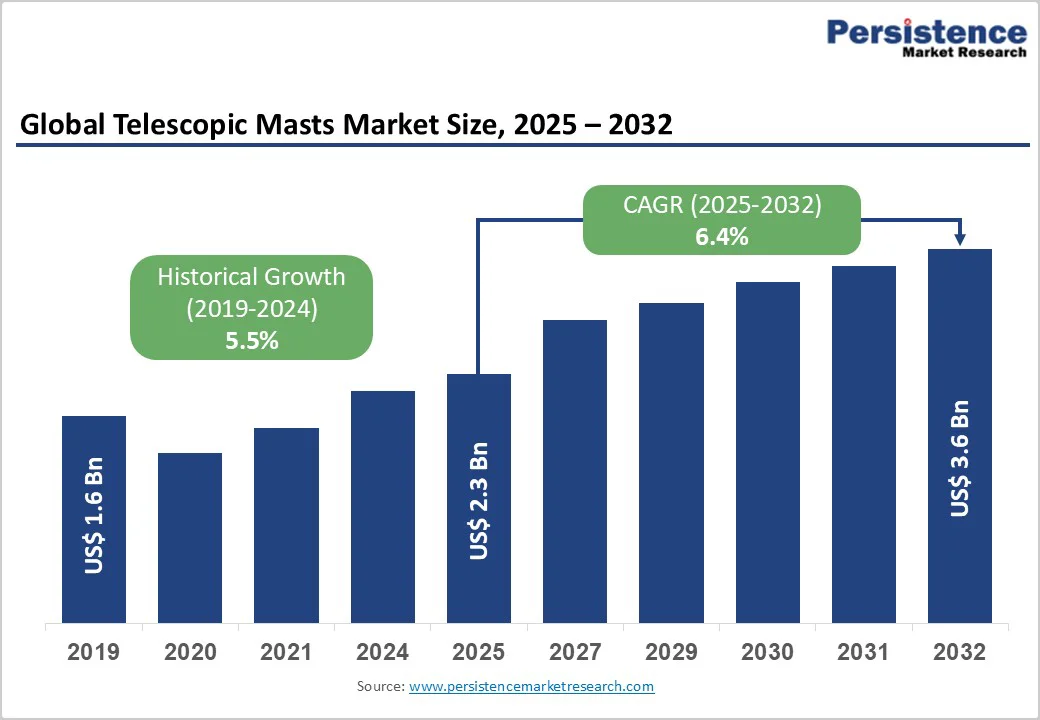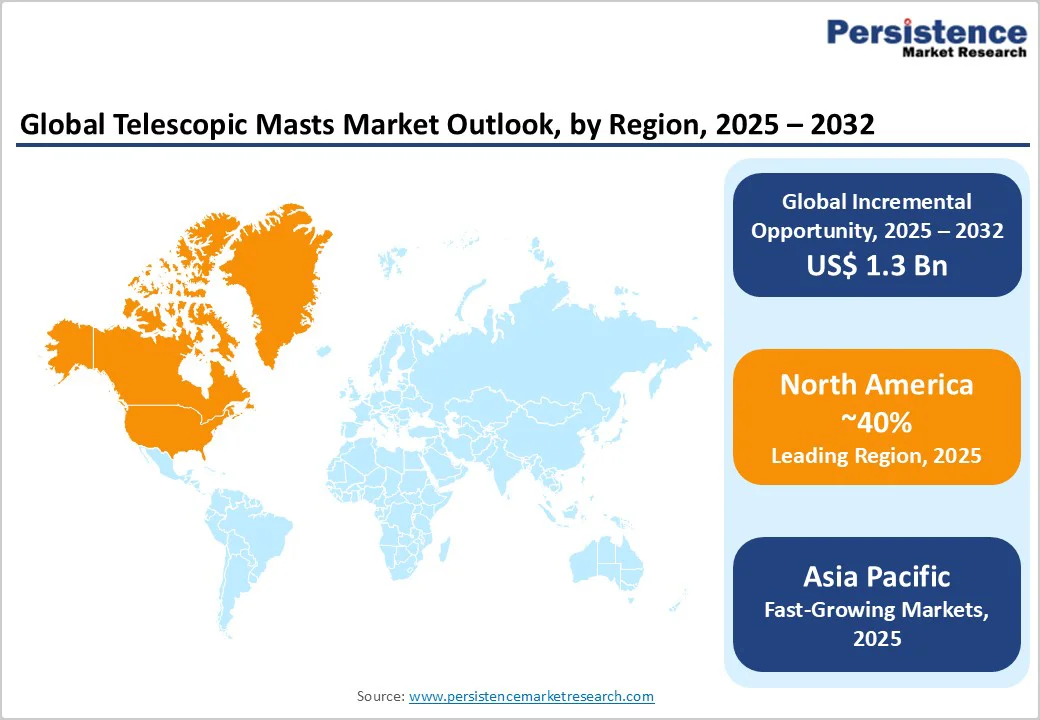ID: PMRREP35875| 199 Pages | 20 Nov 2025 | Format: PDF, Excel, PPT* | Industrial Automation

The global telescopic masts market size is likely to be valued at US$2.3 billion in 2025 and is projected to reach US$3.6 billion, growing at a CAGR of 6.4% between 2025 and 2032.
The market expansion is driven primarily by escalating global defense modernization programs and rising defense spending, supported by increased allocations toward defense-related security investments. Global military expenditure reached US$2.7 trillion in 2024, a 9.4% year-on-year increase from 2023.
| Key Insights | Details |
|---|---|
| Telescopic Masts Market Size (2025E) | US$2.3 Bn |
| Projected Market Value (2032F) | US$3.6 Bn |
| Global Market Growth Rate (CAGR 2025 to 2032) | 6.4% |
| Historical Market Growth Rate (CAGR 2019 to 2024) | 5.5% |

Defense modernization represents the most significant growth driver, with global military expenditure reaching US$2.7 trillion in 2024, increasing 9.4% annually and accounting for 2.5% of global GDP.
NATO member states have committed to increasing defense spending to 3.5% of GDP by 2035, with an additional 1.5% allocation toward defense-related security investments, collectively representing approximately US$ 800 billion in incremental annual expenditure compared to pre-2022 levels.
The top five military spenders, the United States (US$997 billion), China (US$314 billion), Russia (US$149 billion), Germany, and India, collectively account for 60% of global military spending, directly correlating with enhanced procurement of surveillance and communication infrastructure, including telescopic mast systems.
Military organizations increasingly prioritize rapid-deployment communication and surveillance capabilities to support border security, tactical operations, and command center establishment, creating sustained demand for portable mast solutions that offer swift deployment, operational reliability, and adaptive height adjustment across diverse field conditions.
The rapid expansion of telecommunications infrastructure and the global rollout of 5G networks are major drivers of the telescopic masts market. Telecom operators increasingly adopt telescopic masts to support antennas, temporary base stations, and mobile communication systems in both urban and remote regions.
These masts offer quick deployment, adjustable height, and portability, making them ideal for network expansion where constructing permanent towers is costly or impractical.
The accelerating shift toward 5G connectivity demands flexible and elevated platforms capable of supporting higher-frequency antennas and dense network coverage. Governments and private players are investing in smart city projects and rural broadband connectivity, further amplifying the need for mobile mast solutions.
As the demand for high-speed data transmission and reliable communication infrastructure continues to rise globally, telescopic masts are becoming an essential asset for telecom operators and emergency communication providers.
The global telescopic masts market faces a major restraint due to the absence of standardization and compatibility across diverse applications. Manufacturers design telescopic masts for various industries, including defense, broadcasting, surveillance, and disaster response, each with different payload capacities, height ranges, and mounting systems.
Because no universal design or interoperability standard exists, companies struggle to integrate masts with existing equipment like antennas, cameras, or communication systems. This lack of uniformity forces users to purchase customized solutions for each use case, thereby increasing complexity and limiting scalability.
Defense and government agencies, in particular, find it difficult to deploy mast systems across multiple platforms because components from different suppliers rarely align. As a result, users experience inefficiencies and downtime when switching between incompatible models.
The lack of a common technical framework impedes collaboration between manufacturers and system integrators, slowing innovation and hindering the large-scale adoption of telescopic masts worldwide.
Natural disasters, humanitarian relief operations, and emergency response scenarios create substantial demand for telescopic masts for rapid-deployment communication infrastructure, lighting systems, and situational awareness platforms. Emergency services increasingly recognize the telescopic mast's value for establishing command centers, coordinating search and rescue operations, and providing elevated surveillance capabilities during crisis events.
According to law enforcement agency data, 86% of U.S. police departments operate with officer shortages, driving adoption of force-multiplication technologies, including telescopic mast-based mobile surveillance systems, enabling reduced personnel requirements through elevated observation capabilities.
Strategic investments in emergency management infrastructure modernization and disaster preparedness initiatives create premium market opportunities for specialized solution providers offering proven reliability in crisis environments.
Lightweight composite materials, hybrid alloy structures, and advanced manufacturing processes are reducing telescopic mast weight by 30-40% while enhancing load capacity and fatigue resistance, creating opportunities for product differentiation and supporting premium market positioning.
Internet of Things (IoT) sensor integration, enabling real-time monitoring of mast stress, extension speed, and component health, reduces unplanned downtime by approximately 25-35% through predictive maintenance capabilities and remote diagnostics.
Cloud-based control platforms supporting automated deployment, remote operation, and comprehensive operational analytics create intelligent mast systems commanding premium pricing and enhanced customer value propositions.
Hybrid power systems integrating solar generation, kinetic energy recovery modules, and traditional generator backup ensure sustained operation during extended field deployments without logistical fuel supply requirements. These innovations open new growth avenues for premium, technology-driven telescopic mast solutions.
Push-up masts dominate the telescopic masts market with approximately 36% market share, driven by proven operational reliability, mechanical simplicity, and rapid manual deployment requiring minimal operator training. Push-up masts extend to full operational height within 1-2 minutes, providing exceptional deployment speed critical for emergency response and tactical applications.
Will-Burt's Hurry-Up® series achieving 30-foot (9-meter) extension in under one minute exemplifies market-leading performance standards supporting widespread adoption across military, law enforcement, and emergency response sectors.
Medium Duty (45 to 120kg) load capacity segments command approximately 46% market share, representing the optimal capacity range for military communication systems, surveillance equipment, and 5G antenna installations supporting diverse operational requirements. This segment demonstrates exceptional versatility accommodating radio equipment, cameras, thermal imaging systems, and antenna arrays typical of modern tactical and telecommunications applications.
Heavy Duty (above 120kg) holds significant market share, concentrated in specialized applications including multiple antenna arrays, heavy sensor packages, and industrial telecommunications equipment requiring robust load-bearing capabilities. Heavy duty systems project 6.8% CAGR, representing the fastest-growing capacity segment driven by sophisticated military sensor integration and telecommunications infrastructure complexity.
Military applications dominate the telescopic masts market with approximately 39% market share, driven by defense modernization priorities, surveillance infrastructure expansion, and tactical communication requirements across global military operations.
Military organizations increasingly prioritize rapid-deployment mast systems supporting border surveillance, command center establishment, and mobile communication infrastructure for operational effectiveness enhancement.
Commercial applications encompassing telecommunications infrastructure, broadcasting operations, and event coverage require flexible elevation platforms and rapid repositioning capabilities. The segment projects 6.8% CAGR through 2032, representing the fastest-growing end-use category driven by the increasing demand from telecommunications infrastructure and broadcasting operations.

North America maintains regional market leadership with the United States' dominance driven by substantial defense spending (US$ 997 billion in 2024), advanced military infrastructure, and sophisticated emergency response systems.
The U.S. telescopic masts market demonstrates 5.8% CAGR through 2032, supported by military modernization initiatives, border security infrastructure expansion, and emergency management system upgrades across federal, state, and municipal agencies.
Law enforcement adoption accelerates with 86% of U.S. police departments operating with officer shortages, driving mobile surveillance system adoption supporting force multiplier capabilities through elevated observation platforms.
Canada contributes substantially to the regional market with military modernization programs and disaster response infrastructure investments supporting market expansion at a 5.4% CAGR. The region benefits from established defense contractor ecosystems, including companies such as The RATT, Fireco US, and Will-Burt, maintaining technological leadership through continuous innovation in rapid-deployment systems and advanced control platforms.
North American regulatory environment emphasizing safety standards, occupational compliance, and environmental protection drives technology differentiation supporting premium product positioning for manufacturers meeting stringent performance requirements.
Europe represents a significant market capturing approximately 28% global market share, with Germany leading regional demand at 29.1% share through 2032, benefiting from advanced defense technology capabilities and comprehensive security infrastructure.
German military modernization initiatives and defense spending increases supporting NATO commitments drive sustained telescope mast procurement. United Kingdom maintains 21.7% regional share through 2032, supported by military modernization programs and emergency service development initiatives despite budget constraints affecting infrastructure investment timelines.
France holds 18.8% regional share, driven by defense modernization requirements and security infrastructure initiatives supporting sustained market growth. European regulatory harmonization through EU standards ensures consistent technical requirements across member states, supporting manufacturers in achieving economies of scale through standardized product development.
The region demonstrates particular strength in precision manufacturing and advanced material development, supporting composite and hybrid alloy mast production, positioning European manufacturers as technology leaders in lightweight, high-performance solutions commanding premium market positioning.
Asia-Pacific represents the fastest-growing regional market at 7.1% CAGR through 2032, driven by China and India military modernization programs, telecommunications infrastructure expansion, and rapid urbanization requiring advanced communication systems.
China's military spending increased 7.0% in 2024 to US$ 314 billion, representing the largest year-on-year percentage increase since 2015 and the 30th consecutive year of military budget growth according to SIPRI data. China's military modernization emphasizing 30th consecutive year of budget growth supports sustained telescopic mast procurement for surveillance infrastructure and tactical deployment systems.
India's military modernization initiatives combined with 5G infrastructure deployment and defense spending increases, create substantial market opportunities. Japan, South Korea, and Southeast Asian nations, including Thailand, demonstrate accelerating defense spending supporting regional market expansion at a 7.4% CAGR.
The region benefits from manufacturing cost advantages and emerging technology development supporting competitive product positioning, with regional manufacturers increasingly capturing market share through cost-competitive solutions and rapid customization capabilities supporting diverse end-user requirements across military, commercial, and telecommunications applications.

The global telescopic masts market demonstrates moderately fragmented characteristics with top five companies control approximately 35-45% global market share through specialized product portfolios and established customer relationships.
Market leaders compete through comprehensive product portfolios addressing military, commercial, and municipal applications through continuous innovation in lightweight materials, IoT integration, and automated deployment systems.
Will-Burt, The RATT, Hilomast LLC, and RVA Lighting and Masts maintain competitive advantages through established military relationships, proven reliability records, and specialized solution development.
Strategic consolidation trends include technology partnerships combining telecommunications infrastructure expertise with mast engineering capabilities, and material science collaborations developing advanced composite structures supporting next-generation mast platforms.
The global telescopic masts market was valued at US$ 2.3 billion in 2025 and is projected to reach US$ 3.6 billion by 2032, growing at 6.4% CAGR during the forecast period.
Key demand drivers include global military defense spending reaching US$ 2.7 trillion in 2024 with 9.4% year-on-year growth, NATO commitment to increase defense spending to 3.5% GDP by 2035, FCC 5G Fund for Rural America allocating US$ 9 billion, emergency response infrastructure modernization, and law enforcement adoption driven by 86% staffing shortages requiring force-multiplication technologies.
Push-up Masts dominate the market with 36% share, supported by proven operational reliability, mechanical simplicity, and rapid 1-2-minute deployment.
North America maintains regional market leadership with US$ 1.2 billion market value through 2032, driven by United States military spending.
Major opportunities include emergency response and disaster management applications, advanced materials and IoT integration technology development, and supporting predictive maintenance reducing downtime.
Key market players include Will-Burt Company (Ohio, USA), The RATT Inc. (Florida, USA), Fireco US (Arizona, USA), Hilomast LLC, RVA Lighting and Masts, Blue Sky Masts, C&S Antennas, and Mast Systems (Transdigim Inc).
| Report Attribute | Details |
|---|---|
| Forecast Period | 2025 to 2032 |
| Historical Data Available for | 2019 to 2024 |
| Market Analysis | US$ Billion for Value Units for Volume |
| Key Regions Covered |
|
| Key Market Segments Covered |
|
| Key Companies Profiled in the Report |
|
| Report Coverage |
|
By Product Type
By Load Capacity
By Height
By End-user
By Region
Delivery Timelines
For more information on this report and its delivery timelines please get in touch with our sales team.
About Author